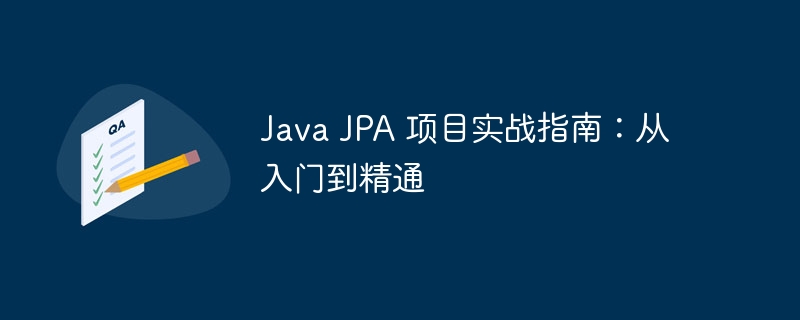

php editor Strawberry has launched a practical guide called "Java JPA Project Practical Guide: From Beginner to Mastery". This book aims to help readers comprehensively master Java JPA technology, and provide practical project experience and skills in the process from entry-level to proficient level. Through this book, readers will be able to have an in-depth understanding of the application scenarios, principles and practical operations of Java JPA, so as to better apply it in actual projects and improve their technical level.
Java JPA (Java Persistence api) is a Java specification that defines the standard for object/relational mapping (ORM). JPA allows development Personnel use the Java programming language for object persistence and interact with the relational database . JPA provides a set of standard annotations and APIs that can map Java objects to database tables and complete data persistence operations.
2. Benefits of using JPA
1. Simplify data access: JPA provides a set of standard APIs that simplify access to the database without directly writing sql statements. 2. Improve development efficiency: JPA can automatically complete the mapping of objects and database tables through annotations, eliminating the need to manually write cumbersome codes and improving development efficiency. 3. Improve application portability: Since JPA is a standard specification, JPA projects can be easily migrated from one database to another, improving application portability.
3. Getting StartedSteps
1. Add dependencies: Add JPA dependencies in the project's pom.xml file. 2. Create entity classes: Create entity classes to represent objects to be persisted. Entity classes need to be annotated using JPA standard annotations. 3. Configure the persistence unit: Configure the persistence unit in the project's persistence.xml file. The persistence unit specifies the database type, connection information and other settings to be used. 4. Create EntityManager: EntityManager is JPA's API for managing persistent objects. It provides access to the database. 5. Use EntityManager for data persistence: Use EntityManager to persist entity objects into the database, or to query entity objects from the database.
4. Concept Demonstration
The following is a simple demo code that shows how to use JPA to complete data persistence and query:
import javax.persistence.*;
@Entity
public class Person {
@Id
@GeneratedValue(strategy = GenerationType.IDENTITY)
private Long id;
private String name;
private int age;
// 省略 getter 和 setter 方法
}
public class JPAExample {
public static void main(String[] args) {
EntityManagerFactory emf = Persistence.createEntityManagerFactory("my-persistence-unit");
EntityManager em = emf.createEntityManager();
// 创建一个Person对象
Person person = new Person();
person.setName("John Doe");
person.setAge(25);
// 将Person对象持久化到数据库
em.getTransaction().begin();
em.persist(person);
em.getTransaction().commit();
// 从数据库中查询Person对象
Person foundPerson = em.find(Person.class, person.getId());
// 打印Person对象的信息
System.out.println("Person: " + foundPerson.getName() + ", Age: " + foundPerson.getAge());
// 关闭EntityManager和EntityManagerFactory
em.close();
emf.close();
}
}5. Advanced usage
1. Cascading operations: JPA provides cascading operations, allowing corresponding operations to be automatically performed on child entities when operating on parent entities. 2. Query language: JPA provides JPQL (Java Persistence Query Language) query language. JPQL is similar to SQL, but it targets the object model. 3.TransactionManagement: JPA provides transaction management functions to ensure the atomicity and consistency of data operations.
6. Best Practices
1. Use appropriate entity mapping strategies: JPA provides a variety of entity mapping strategies, and the appropriate strategy should be selected based on actual needs. 2.Optimizequery performance: You can use JPQL query hints, batch processing and caching and other technologies to optimize query performance. 3. Use transactions to ensure data consistency: When performing data operations, transactions should be used to ensure data consistency. 4.Log and exception handling: Logging and exception handling should be used in the application to record and handle errors in JPA operations.
The above is the detailed content of Practical Guide to Java JPA Projects: From Getting Started to Mastery. For more information, please follow other related articles on the PHP Chinese website!
